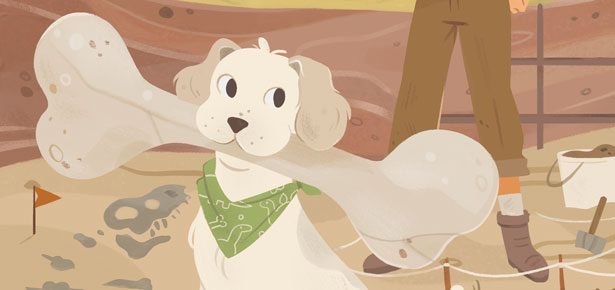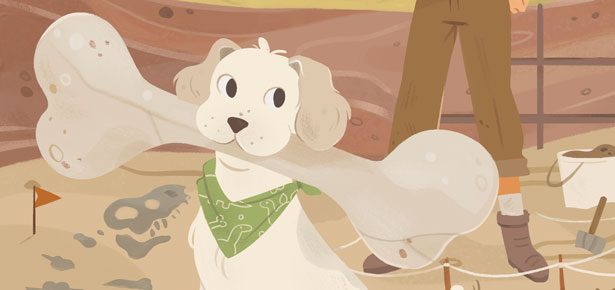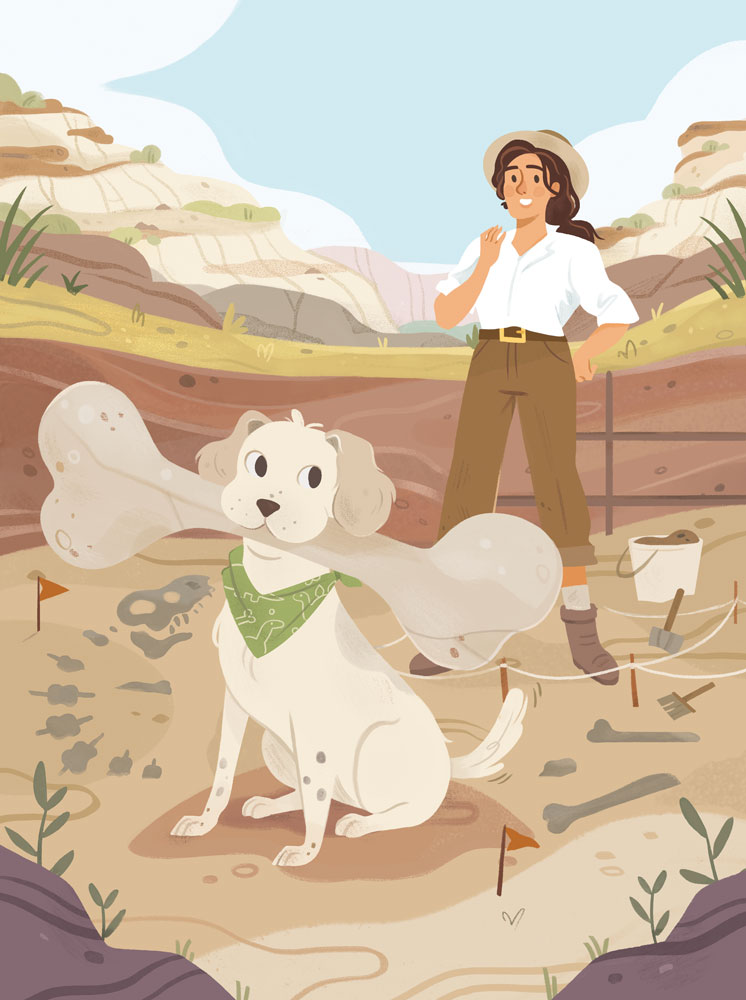

Dogs, an Archaeologist’s Best Friend
The amazing noses of canines are locating remains that are thousands of years old
As improbable as it might seem, archaeologists are demonstrating dogs can detect human remains that are thousands of years old.
I was having some coffee on campus when a colleague from the Anthropology Department sat down beside me. “I think I have something here that may amuse you,” she said as she rummaged through her oversized handbag, pulled out an iPad, and a moment later showed me the image on its screen.
I found myself looking at a cartoon showing a stereotyped paleontologist standing near a dig site and talking to someone who looked like a reporter. The caption read “We have been so successful at discovering dinosaur remains because we recently added a bone specialist to our team.” Behind him you could see a dog standing and holding a huge dinosaur leg bone in its mouth.
I chuckled while she added, “Wouldn't it be wonderful if dogs could actually do that?”
I replied, “Well, finding dinosaur remains may be a bit far-fetched, but we are actually beginning to see the use of what may be called ‘archaeology dogs,’ which are being used to find human remains that may be many centuries old.”
This all came about as an extension of the work done by cadaver dogs. These are dogs that are typically used in criminal cases to help find human bodies that may have been buried or otherwise hidden. These dogs are really good at finding human remains that are hours or weeks old, but they also do well at detecting bodies which may have died years or even several decades ago. Biochemists have shown that the “scent of death” is complex and seems to contain more than 400 different components which are slowly released after an individual has died. These human-remains detection dogs can be trained to use their remarkably sensitive noses to detect these trace elements associated with decomposition of a human body despite a significant passage of time. However, the leap from a cadaver detection dog to one which can detect historical remains of sufficient age as to be of interest to archaeologists seems to be a stretch. Is it asking too much, even of dogs with their remarkable olfactory abilities?
In 2012, Gary Jackson, an Australian dog trainer, set out to answer this question, investigating if a dog could be trained to find older examples of human remains. His research was prompted by the Australian government’s efforts to curb developments that might disturb aboriginal gravesites. Adding to the challenge is the fact that many of these burial grounds are hundreds of years old, and the location of individual graves has been long forgotten.
Gary set about training a black Labrador Retriever mix named Migaloo υ to detect human bones and to ignore other odours associated with decomposition. First he got permission from the Aboriginal tribal elders to use some ancestral bones from the South Australian Museum's collection. Then he re-created an Aboriginal graveyard and also scattered some animal bones there as distractors. What he saw was that the dog was able to find a buried bone from about ten feet (three meters) away, even if it was as small as a fingernail. Ultimately, he could even just take a cotton ball, touch the bone, and touch that to a rock—and Migaloo could still detect the smell on the rock.
As a sort of “proof of concept,” Migaloo was then taken to an aboriginal burial ground in South Australia, where a 600-year-old grave had been found a few years ago. Gary and Migaloo were given about an acre (0.4 hectare) to search. The museum officials and tribal elders were there, and while they knew where the graves were, Gary did not. It took Migaloo less than five minutes to detect the remains that had been buried some six centuries ago.
A dog named Fable was able to find even older remains. In Sweden in 2015, archaeologist Sophie Vallulv tested a two-year-old black German Shepherd, who had been purposefully trained to find human skeletons. Sophie was studying the ruins of a silver mining community built during the sixteen hundreds, located where the mountain stream of Silbojokk flows into the Lake Sädvajaure. This is a particularly difficult set of ruins to study since investigations can only be carried out during a few weeks in early summer, before the water rises up over the area. Therefore, quickly locating probable burial sites is vital if the archaeological research is to be done. In the case of Fable, laboratory and field testing showed that he could distinguish between human and animal bones with remarkable accuracy (a detection rate of 94.2 percent). During actual field searches, Fable has found bones that were later dated to be 1,600 years old. He has detected remains buried up to a depth of 5 feet (1.5 meters). He may be capable of detecting deeper remains, but Sophie's husband refuses to dig test pits that are deeper than a meter and a half.
Perhaps the most impressive performances by a team of archaeological dogs come from the recent collaboration of Vedrana Glavaš, an archaeologist at the University of Zadar in Croatia, and Andrea Pintar, a cadaver-dog handler. Vedrana was working at a hilltop fort called Drvišica along Croatia’s Adriatic coast. Her team had identified tombs in what appeared to be a cemetery near the fort and they wanted to find more. Unfortunately, the irregular, rocky terrain made it difficult to just randomly excavate suspected burial sites.
Although the dogs (a German Shepherd and a Belgian Malinois named Sattve and Mali respectively) were well trained cadaver dogs, Vedrana needed to be sure that they could detect remains which might have been in the ground for several thousand years. To test the dogs, Vedrana let them sniff around an area where she had excavated three gravesites the year before. It is important to note that the human remains had already been removed, and due to a year's worth of weathering one could no longer find any visible evidence of where the excavations had taken place. The two dogs, working independently, easily located all three gravesites, confirming their ability to do the work.
The dogs were then brought to another site in the region where it was suspected that there were more graves. These particular graves are somewhat unique in that they each contain a small stone burial chest which usually holds small finger and toe bones and a few artefacts. When allowed to sniff around this new site, the dogs were able to locate six graves. Some of these graves date back to the eighth century BC, which is close to 3000 years ago.
Because of the expense and difficulty in excavating a grave, Vedrana always uses at least two dogs to confirm the position, making sure that the second trainer and dog are not told where the first team had indicated a grave.
Although the bone fragments in these graves are very old, the guess is that the age of the bone doesn't matter as much as the environment in which it rests. Factors such as sunlight, moisture, and temperature will all impact how much scent the remains will give off. In this particular case, the bones were laid on slabs of limestone and it may well be that as they decomposed the compounds leached into the rock which then trapped the scent for centuries waiting for an inquisitive canine nose to rediscover them.
“I don't think that we will actually be able to extend this kind of searching to include dinosaur bones, however,” I explained to my colleague, “since most of dinosaur remains are petrified, which means that the organic material that makes up the bone has been replaced with minerals. This means that the resulting fossils don't really smell like organic remains anymore. Of course, if we could find a place where dinosaurs recently died and have not been completely fossilized we might be more successful…”
Join the newsletter and never miss out on dog content again!
"*" indicates required fields
By clicking the arrow, you agree to our web Terms of Use and Privacy & Cookie Policy. Easy unsubscribe links are provided in every email.





